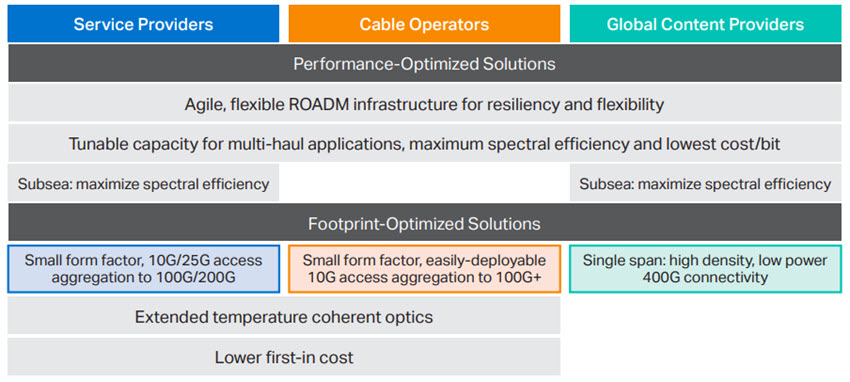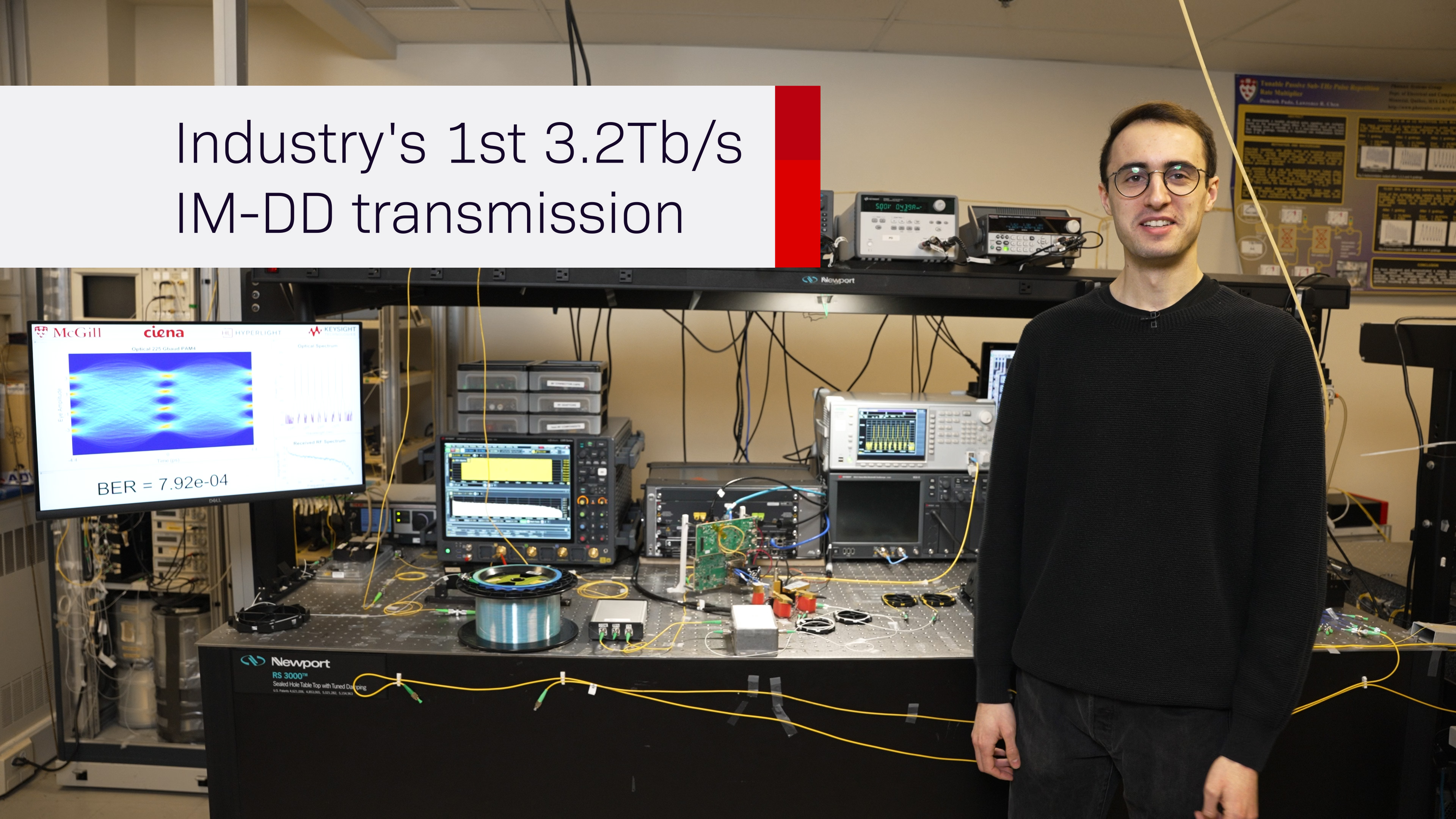The evolving coherent optical networking landscape: a deep dive
Network providers, which include telecom Service Providers, Cable/Multiple System Operators (MSOs), and Global Content Network Providers, are all facing business challenges that are forcing them to evolve and transform their networks.
Service Providers
In order to retain and grow their customer base, service providers are investing to offer innovative services – like delivering original video content (AT&T acquiring Time Warner) and enabling connectivity of “smart” devices both in the home and in a mobile setting (Bell’s managed security IoT service). They are also evaluating and upgrading to new, simpler, scalable access architectures, to be able to offer new services unlocked with 5G. One notable example of spending shifting to the edge is Verizon’s announced $1B spend over 3 years for fiber from Corning, as well as their purchase of WOW’s Chicago fiber-based infrastructure.
Challenged with a multi-vendor infrastructure consisting of various technology generations, service providers are working to streamline operations and increase network automation to accelerate service delivery and improve customer satisfaction. At the same time, they are looking to increase operational efficiencies and reduce costs with a more open, programmable infrastructure that can quickly respond to new bandwidth demands with less deployed hardware.

Cable/Multiple System Operators (MSOs)
Cable/MSOs are modernizing their access architectures – pushing fiber closer to the end user, distributing and virtualizing functions – to realize operational efficiencies, provide higher-capacity connectivity and deliver a better quality of experience. They are replacing their legacy analog infrastructure with a completely new digital fiber network to gain economic and competitive advantages. With the objective of deploying 10X the number of deployed fiber nodes, selecting the right architecture with equipment that can withstand the outside plant environment, need only be wired once and can scale to support gigabit access and new services, is critical. Deploying the appropriate software architecture that can efficiently manage the end-to-end network with increased automation is just as important for a successful transformation.
Global Content Network Providers
Global content network providers are experiencing yearly double-digit bandwidth growth and are expanding their metro, long haul and submarine data center infrastructures accordingly (new Facebook data center in Singapore). In the metro, to scale for bandwidth growth, they are distributing their metro-regional data center fabric across multiple buildings or campuses, which drives growing requirements for single-span, high-capacity optical connectivity. From an architecture perspective, they embrace advanced technologies and software practices, including software-defined networking and artificial intelligence, to maximize efficiencies. They thrive on delivering new innovative services to their customers, predicting what end users want before they even ask for it! They are early adopters of state-of-the-art technologies and will be moving from 100G-interface to 400G-interface routers in the near term as these become available.
Consistent among all network providers is the need for a more responsive, automated, and self-optimizing network. Technologies such as advanced coherent optics, alongside a flexible photonic layer and open application programmable interfaces (APIs) play a starring role in making this possible. In the past few years, network providers have focused significant effort in upgrading their optical networks to satisfy these requirements, utilizing automation, analytics and intent-based policies to rapidly scale, self-configure, and self-optimize the network. Ciena calls this new network state the Adaptive NetworkTM.
The evolving role of coherent technology
To successfully address their dynamic business challenges, network providers are strategically looking to expand the role of coherent technology to include the new network architectures borne from the business drivers mentioned above. Based on the application, a divergent set of coherent solutions are emerging: performance-optimized and footprint-optimized solutions. Performance-Optimized Solutions are designed to provide best system performance without constraints, while also enabling maximum optical layer automation. Footprint-optimized Solutions are optimized to fit into a specific form factor and power envelope.
Based on the application, a divergent set of coherent solutions are emerging: performance-optimized and footprint-optimized solutions.
Performance-Optimized Solutions
For metro and long-haul infrastructure applications, including global DCI networks, the evolution to the Adaptive Network is already underway. Network providers are increasingly moving to more software-driven, automated, highly scalable networks that promise new efficiencies, cost savings and service agility. The optical network is no longer seen as a ‘dumb pipe’. Rather, there is a growing need for an agile, resilient, ROADM-based optical foundation that depends on flexible, instrumented photonics and Layer 0 software control to scale the network for maximum capacity at lowest space, power, and cost per bit.
The optical network is no longer seen as a ‘dumb pipe’. Rather, there is a growing need for an agile, resilient, ROADM-based optical foundation that depends on flexible, instrumented photonics and Layer 0 software control to scale the network for maximum capacity at lowest space, power, and cost per bit.
For these infrastructure applications, performance-optimized coherent solutions that can tune to provide optimal capacity across any network path are required. To achieve maximum flexibility and resiliency, direct communication from transponder to photonic line is required, which is best achieved with a highly-optimized transport platform. With 400G-interface routers on the horizon, the ideal optical solution must also facilitate network evolution to next generation, higher capacity switching technologies and support universal transport of emerging client rates such as 400GbE.
Network providers also require performance-optimized solutions in applications where fiber resources are limited, and maximum spectral efficiency is the predominant requirement. Submarine systems which comprise thousands of kilometers of submerged cables are a good example of such an application.

Divergent network evolution transport requirements
Footprint-Optimized Solutions
The launch of fiber densification initiatives and higher per-flow bandwidth requirements, combined with cost and power reductions now possible with next-generation coherent solutions, are opening the access space as an entirely new market for coherent solutions. And as we move towards access applications, whether it be for cable/MSO or service provider networks, requirements change.
Physical size constraints and an extended operating temperature are more important than ultimate wavelength capacity in these applications. Network operators need small form factor, easily-deployable solutions that can aggregate multiple access connections and backhaul traffic to a central location over a single, smaller-size (e.g., 100G) wavelength.
Integrating coherent optics and packet switching in the same platform further maximizes efficiencies and simplifies the network, spurring innovation and development of new packet-optical products in the industry. With recent advances in digital signal processing (DSP) chip and electro-optical component designs, coherent optics can now be implemented in standards-based pluggable forms. Line interoperability is an important benefit for these point-to-point access applications since access and aggregation platforms are typically sourced from different vendors. Line interoperability provides efficient, direct connectivity and eliminates the need for optical-electrical-optical (O-E-O) conversion equipment.
The launch of fiber densification initiatives and higher per-flow bandwidth requirements, combined with cost and power reductions now possible with next-generation coherent solutions, are opening the access space as an entirely new market for coherent solutions.
To address power and space concerns for data center interconnect (DCI) applications, global content providers are also planning on using coherent pluggables, specifically for a portion of the single-span DCI, or “400ZR” market. A key requirement for adoption in this application space is that no compromise be made to packet switch density due to the inclusion of coherent optics. As power drives service density, low power consumption is critical. Another important attribute for 400ZR applications is coherent line interoperability to simplify network operations. Finally, support of 400G wavelengths to scale fiber capacity and efficiently interconnect 400G routers is another important requirement.
Footprint-optimized solutions provide additional flexibility in bringing coherent technology with its scalability and ease-of-use benefits into new parts of the network. The high bandwidth connectivity to end users and devices allow for the introduction of new innovative services and helps network providers evolve towards more adaptive networks.
In 2019 and beyond, we will see these new network architectures being built, and the resulting applications and services they make possible. It is very exciting to see the critical and expanding role coherent technology is playing in this journey to scale capacity, introduce more programmability and achieve business objectives. And we’re just getting started.






